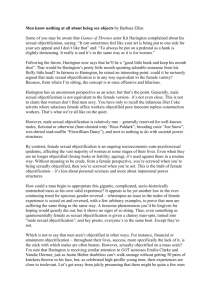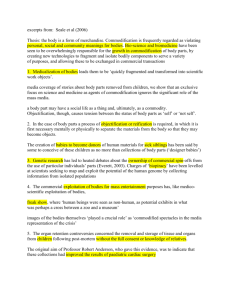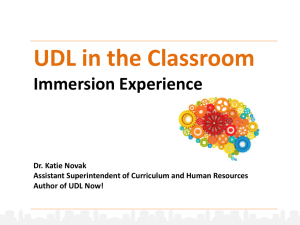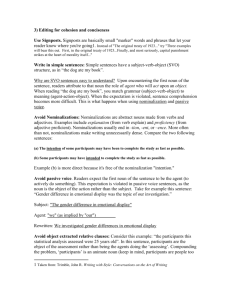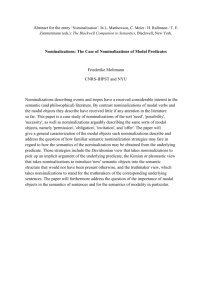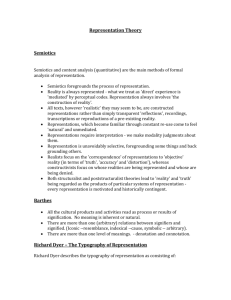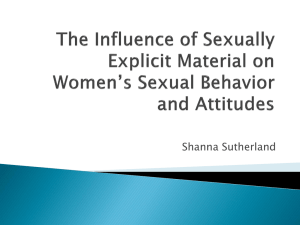Objectification and the Inscription of Knowledge in Science
advertisement
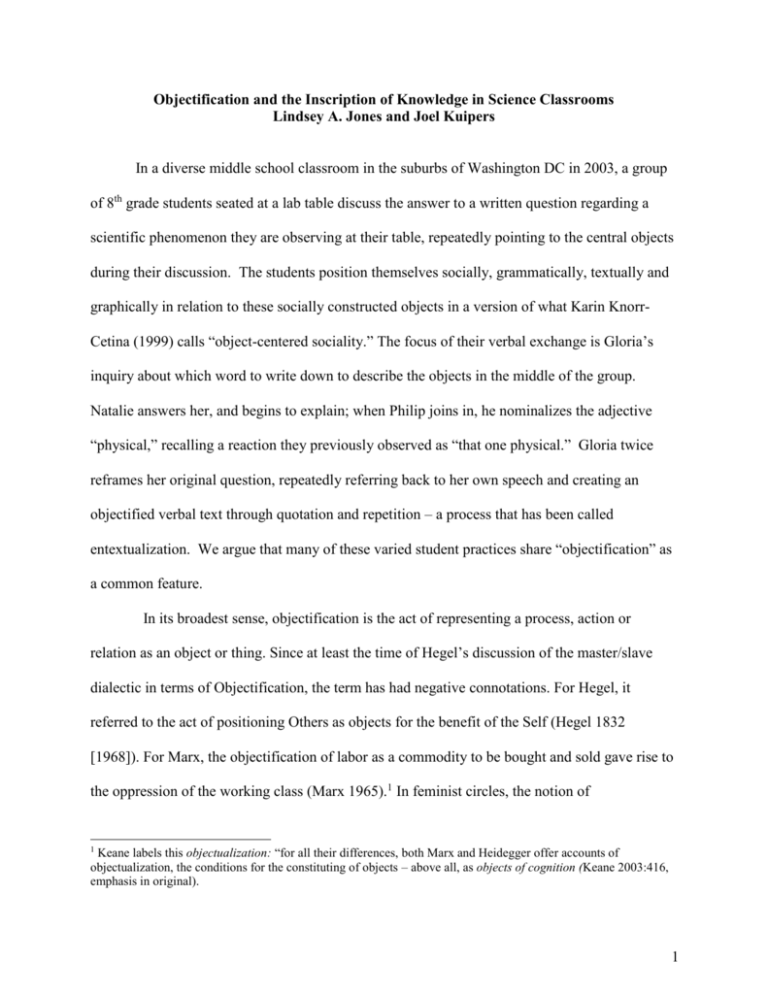
Objectification and the Inscription of Knowledge in Science Classrooms Lindsey A. Jones and Joel Kuipers In a diverse middle school classroom in the suburbs of Washington DC in 2003, a group of 8th grade students seated at a lab table discuss the answer to a written question regarding a scientific phenomenon they are observing at their table, repeatedly pointing to the central objects during their discussion. The students position themselves socially, grammatically, textually and graphically in relation to these socially constructed objects in a version of what Karin KnorrCetina (1999) calls “object-centered sociality.” The focus of their verbal exchange is Gloria’s inquiry about which word to write down to describe the objects in the middle of the group. Natalie answers her, and begins to explain; when Philip joins in, he nominalizes the adjective “physical,” recalling a reaction they previously observed as “that one physical.” Gloria twice reframes her original question, repeatedly referring back to her own speech and creating an objectified verbal text through quotation and repetition – a process that has been called entextualization. We argue that many of these varied student practices share “objectification” as a common feature. In its broadest sense, objectification is the act of representing a process, action or relation as an object or thing. Since at least the time of Hegel’s discussion of the master/slave dialectic in terms of Objectification, the term has had negative connotations. For Hegel, it referred to the act of positioning Others as objects for the benefit of the Self (Hegel 1832 [1968]). For Marx, the objectification of labor as a commodity to be bought and sold gave rise to the oppression of the working class (Marx 1965).1 In feminist circles, the notion of Keane labels this objectualization: “for all their differences, both Marx and Heidegger offer accounts of objectualization, the conditions for the constituting of objects – above all, as objects of cognition (Keane 2003:416, emphasis in original). 1 1 objectification has visual, emotional and similarly negative connotations: Pornography is an example of the objectification of women by men (de Beauvoir 1949). More recently, Bourdieu (1980) criticized both the Saussurian objectification of language in linguistics, and anthropology’s tendency to objectify explanations to the point that they come to be viewed as a cause of the practices they were meant to explain. In cognitive fields of study, objectification as a concept has not always been so freighted with moral connotations. In his Metaphysics in 1859, Hamilton speaks of “this discrimination of self from self, this objectification, is the quality which constitutes the essential peculiarity of Cognition.” Principia Cybernetica also suggests a more neutral cognitive understanding of objectification: “We often think and speak about a process as something definite, constant – in other words, as an object. Then we objectify it, i.e. replace the process, in reality or in our imagination, by an object. The most usual form of objectification is definition.” Additionally, Hegel described the objectification of one’s own ideas as a crucial element of self-creation, adding that “all human history is a process whereby ideas objectify themselves in material reality.” We do not come here to praise objectification as part of cognition, nor to condemn its role in social relations yet again. Rather, in light of Webb Keane’s recent call for an ethnographic analysis of objectification as a human activity, we wish to explore what it is and how it manifests in everyday human interaction. Keane urges that we “take seriously the materiality of signifying practices and the ubiquity and necessity of conceptual objectification as a component of human action and interaction.” (2003:223) He even goes so far as to suggest that objectification is integral to human activity: “far from being only a disease of social science, [objectification] is the very politics of everyday awareness and interaction.” (2003:239) He implies that it is 2 inherently neither good nor bad, but rather that value judgment of action simply depends on how it is used as a human practice: “in contrast to the romantic critique of objectification as, say, inherently alienating or a violation of self-presence (see Miller 1987), whether objectification is negative or not is a function of who I am for you and what epistemic status I accord that moment of objectification.” (2003:239) Objectification exists as an interrelational semiotic practice, and as such, has important social consequences, which, although potentially negative, are far from being inherently so.2 In this panel, we wish to push the notion of objectification a bit further, exploring objectification as a form of participation. Following Goodwin and Goodwin, participation “refers to actions demonstrating forms of involvement performed by parties within evolving structures of talk.” (2004:222) This includes actions by which participants display to one another what they are doing and how they expect others to align themselves toward the activity of the moment. Within this paper, we are not using the term participation to refer to more general membership in social groups or ritual activities. Rather we draw also here on the work of Lave and Wenger (1991), for whom participation stands for actions that are more or less peripheral to culturally defined activity systems. In this model, cognition is not viewed as something occurring exclusively inside people’s heads, but rather as a public and collaborative event among participants. As a form of participation, cognitive activity is something to which one can be apprenticed, and gradually come to master as an expert. In light of this theory of learning as participation, we view objectification as a shift in frameworks of participation and practice within culturally defined activity systems. We consider the implications of this analytical move for ideas about learning, particularly science learning. 3 Objectification is often viewed as involving a transformation of consciousness; but since this change in interior states is not observable, we aim to find manifestations of objectification in the discursive and ethnographic record of interaction. In this panel, we are focusing on evidence of objectification in the discursive practices of students in a middle school science classroom, specifically through nominalization, entextualization, literacy events, and processes of identification. A number of words describe processes related to objectification: inscription, reification, hypostatization, embodiment, actualization, externalization, realization, even estrangement. There are no doubt others. While one or more of these words could conceivably be used as a substitute, as our focus is on science classrooms, the term objectification, which resonates with notions of scientific objectivity, seems most appropriate to our interests. Science classrooms are a particularly good place to look for objectification in practice. Classrooms in general tend to be places where knowledge is broken down into digestible chunks, often packaged and re-packaged into different forms in relation to the different subjective perspectives of the students. Science classrooms are especially interesting because they display many aspects of the “object-centered sociality” that Karin Knorr-Cetina says characterizes adult science laboratory culture (Knorr-Cetina 1999). According to her, science is a culture in which participants define their relations to each other by their orientation toward common objects. In what follows, we will attempt to place some salient features of objectification in the context of relevant anthropological, linguistic and philosophical literature. We will show the importance of nominalization, identity, literacy events and entextualization as semiotic practices in classrooms, and argue that an important common theme that they all share is objectification. 4 We will provide brief references to the ways in which the chapters assembled here fit into those themes, but we will leave the elaboration of the themes to the authors themselves. Nominalization as Linguistic Evidence of Objectification According to the educational philosophy of John Dewey, the focus of education should not be on knowledge, which seems to be a static “thing” that we acquire, but on inquiry, which is an activity. As Rockwell (2001) observes “For Dewey, ‘knowledge’ was rather like a nominalization of a verb, rather than a genuine noun, and he was vigilant in exposing the confusions that resulted from ignoring this. Much of his Democracy and Education is devoted to exploring the damage done by the assumption that knowledge is a commodity, and that the goal of education is to cram as much of that commodity as possible into a person’s memory.” The first ethnographic and linguistic example of objectification we wish to consider is thus nominalization. Nominalization is the grammatical process of turning a verb, adjective, or sentence into a noun or noun phrase. It is a nearly universal feature of languages, although it may appear more often in certain languages or speech registers. In effect, nominalization “thingifies” and thus “objectifies” (in our terms) an action, process, or description. Most languages permit the nominalization of at least some verbs, and when they do so, the resulting expression is typically semantically and/or grammatically “marked.” Croft (1990:141) observes that “basic verb concepts, denoting processes and actions, are marked when they serve as referring expressions (nominalizations, complements).” One significant area of variation among languages in the realm of grammatical nominalization is the extent to which they permit the nominalization of verbs of saying. Some languages, such as Sherpa, will permit grammatical nominalization of all other verbs BUT verbs of saying. (Croft 1990:181). 5 Nominalization as a process has attracted the attention of philosophers, literary critics, and linguists for nearly a century. In an early discussion of nominalization, Bertrand Russell argued that nominalization was problematic for the creation of assertion, saying that the truth of a sentence is no longer verifiable once the sentence is nominalized – the meaning becomes merely implied. Because he was concerned with truth value, Russell dealt with sentential nominalizations, which rely on a subject combined with a nominalized verb, not with nominalizations composed of a single nominalized word. For example, take the sentence, “The murder of Tom Smith was deplored by Dan Jones.” Russell would argue that this statement does not actually claim that Tom Smith was murdered, but rather that it only claims that Dan Jones deplored the implied murder of Tom Smith. What concerns us here are the implications of Russell’s observations for nominalization as a form of participation. Inasmuch as “the murder of Tom Smith” is contained in a nominal phrase whose truth value cannot be verified, this grammatical move places the nature of Tom Smith’s demise in the background, in the realm of implicit knowledge. Any challenge to this knowledge becomes more marked interactionally, and more disruptive of the social interactional flow. As an ethnographic and linguistic practice, nominalization is part and parcel of the process of establishing and maintaining “face” and indeed one’s authority in the context of social interaction. Zeno Vendler (1967) focuses his discussion of nominaliztion on ideas embedded in other ideas within a sentence. Vendler details two ways a sentence that is turned into a noun phrase can be incorporated into another sentence. One way is by use of a restrictive clause (e.g., “The man you love must be generous” derives partially from the statement, “you love a man”). The other way is by a “proper nominalization,” where a sentence is nominalized and placed it into 6 what Vendler calls a “noun gap” in another sentence, or a lexical requirement of a noun complement. In this second case of proper nominalizations, he distinguishes four elements: (1) nominal: a noun phrase formed as a product of a proper nominalization; (2) matrix: a sentence before it is nominalized; (3) container: a sentence with a noun-gap requiring a nominal (rather than an un-nominalized noun); and (4) nominal compound: the resulting sentence formed of the container with the nominal. We find this categorization helpful in examining ethnographic data of sentences which include nominalized phrases, because it allows us to discuss the variation within and between nominalized sentences as they appear within the classroom. Within the field of formal linguistics, significant work on the grammar of nominalization began with Lees’ The Grammar of English Nominalizations (1960), where he argued for a transformationalist approach to the topic. This type of approach describes nominalizations as a grammatical process deriving a noun phrase from a verb phrase or sentence. Chomsky called this into question in his Remarks on Nominalization (1968) by arguing that the lexical constraints on a verb or adjective affect its nominalization. In an apparent exception to Chomsky’s well known syntacticism, he cited the example of John is easy to please John is eager to please John’s eagerness to please BUT: *John’s easiness to please Where easy and eager are grammatically similar, they have different semantic constraints which govern their nominalization. Nominalization is therefore not solely a grammatical process; the meaning of the words affects, and is affected by, the process. This has implications for our work because word meaning is crucial to learning and knowledge as it is built through language. 7 When words are nominalized, their meaning affects the grammatical process and therefore affects the process of building implicit knowledge through language. These philosophical and linguistic descriptions of nominalization are somewhat helpful in beginning to understand what students are doing when they nominalize. However, they do not address the uses of such grammatical constructs as part of a social context; this kind of inquiry began more recently. One of the first efforts to do this was the work of Halliday and Martin (1993), who examined the role of nominalization in scientific writing. Some might go so far as to argue that nominalization is a defining characteristic of scientific writing and scientific thought. For example, insofar as scientific thinking is cumulative, and builds on previous discoveries, nominalizations also place knowledge depicted in previous sentences as the subject of a new one. e.g. (1) The water decomposed. (2) The decomposition of water involved formation of new molecules. Communicating the idea represented in sentence (2) through language requires that the idea that “the water decomposed” be placed in the subject position of another sentence. An English speaker cannot say, “The water decomposed involved formation of new molecules,” and therefore the first sentence (a matrix in Vendler’s terminology) must be put into a nominalized form (Vendler’s nominal) so that it can be implied and added to in the second sentence, the product of which Vendler terms a nominal compound. Nominalizations also represent a kind of syntactic “black-boxing” (Latour & Woolgar 1986), in which the nounifying or “thingifying” process of nominalization disguises its own agency – where it came from, who made it, how it came to be. Latour argues that in the process of developing scientific knowledge, laboratory scientists eventually come to accept certain claims as “true,” thus placing them into a “black box,” protected from epistemological 8 challenges and peer critiques. In the same way, nominalizations harbor an implicit claim, but – as Russell pointed out – they do not overtly make an assertion that can be contested. e.g., “The weight changed….” In this case, even though the word ‘weigh’ does not appear in a grammatical object position, it is, nonetheless “objectified” in the sense stated at the beginning of this essay: it represents a process, action or relation (i.e., ‘to weigh’) as an object or thing (i.e., ‘weight’). Insofar as learning science is a matter of learning how to “talk science,” (Lemke 1990; Roth 2005), nominalization can be viewed as a way of participating in a scientific community of practice. When students use nominalizations appropriately, it has observable consequences for the ways in which they interact with others at their lab tables. It affects how they fashion their identities, as well as their relative authority as sources of scientific knowledge. An important question that remains is how the use of nominalizations is linked to more traditional measures of scientific knowledge on assessments. In the paper by Viechnicki and Kuipers, 8th grade children in a culturally diverse science classroom in the Washington DC suburbs struggle to use language to represent one of the more difficult ideas in middle school science: the conservation of matter. Since it is not practical for classes to observe matter in a pure state (i.e. in a weightless environment), in most science classrooms, students experience the conservation of matter by measuring expected and actual differences in how much objects weigh before and after certain chemical changes. Part of the process involves teaching the students to master what is for them an unusual locution: the use of the verb ‘to weigh’ as a noun in the subject position. Graphic Objectification 9 Writing is another way of transforming intangible descriptions into object-like entities. Just as nominalization turns a verbal or adjectival representation into a “thing” as a noun, writing converts an idea into a concrete graphic object. Writing is a way of fixing knowledge in place – in a single physical space on a material medium such as paper – in order to preserve it for future reference or possibly for new generations. It allows assumed knowledge to be placed on a page and collected within a body of written texts with information that scientists position as background knowledge about the natural world. When scientists have collected data and found “results,” these results are written down because the scientists have a fair amount of certainty that what they claim is true enough that it should be added to the body of scientific knowledge. Similarly, students in science classrooms write answers on worksheets that will be graded, and therefore usually inscribe on the page the words in which they have relative certainty, or which they believe hold authority as graphic responses. In this way, the students are beginning to explore the cultural world of science through a similar use of graphic objectification of knowledge through written language. Unlike nominalization, graphic objectification or writing, at least since Morgan and Tyler more than a century ago, has been viewed as a marker of a great cognitive divide, separating primitive from civilized, simple from complex, spontaneous timeless consciousness from linear rational consciousness, charismatic personalistic reasoning from legal rational principles. It has thus become a focus of ideological constructions and an evaluative mechanism for judging societies and indeed social relations more generally. There is still a central focus in Western educational systems on literacy and the ability of children to interact with print. American school systems devote considerable effort to the use of print resources such as textbooks, lab manuals, and literary reading, and also require the students 10 to objectify their own ideas on paper, which becomes the main source of students’ academic evaluation. The amount of objectified text that students encounter and are required to produce over the course of their education is significant. Thus it is important to consider how it is that students interact with print, how they objectify ideas onto paper. Recently, ethnographers have turned their attention to these important processes of writing in real social situations and have discovered a far more interesting and complex picture than the dichotomy between the supposedly superiorly literate and the dysfunctionally illiterate. Far from being a great technological and ideological divide separating oral from literate culture, it can be viewed as one resource among many possibilities available to actors participating in a communicative activity. Rather than looking at literacy externally as an evaluative criteria to classify societies and types of people, it can be viewed from an insider, actor oriented perspective as a skill individuals make use of in some situations but not in others. As such, the unit of study is better viewed as what Street, Heath and others have called Literacy Events. From the perspective of the actor within a communicative activity, researchers can examine what kinds of things one is likely to produce or receive via print, rather than through vocal speech or some other means. Derrida (1976) in some ways preserves the oral/literate divide while also turning it on its head. As part of his quest to consider the relationship between speech and writing, he criticizes the view that frames writing as derived from speech, because in terms of their capacity to represent the logos or truth, writing is prior and superior. He argues that this is because writing captures, inscribes and objectifies the truth of what is said, while speech merely depicts it and it disappears as soon as it is uttered. But in order for Derrida to seriously hold such a view, he has 11 to ignore the dynamics of spoken discourse, which is manifestly organized in terms of differences of authority in what is said. In this session, we adopt an ethnographic perspective of writing as objectification through print. We start with the assumption that talking and writing are things that people DO in everyday interactional situations. In this case, they are things that children DO in classrooms. As Perry Gilmore has pointed out, talking is something that children get in more trouble for than anything else. Talking provides opportunities for sociability, popularity but also great humiliation; writing can be more solitary, can require more planning, and is often associated with positively sanctioned classroom behavior. Both talking and writing have serious social consequences for students within the classroom, in their relations with other students and also with the teacher. The role of graphic objectification in learning varies by curriculum unit, by student, and by culture. In some curriculum units, student learning is focused on producing correct written responses to workbooks. In other curriculum units, more verbal interaction is required. Some students feel more comfortable writing than speaking, while others may feel more comfortable the other way around. We want to look at some of the ways in which things are written and said, and the relations between those two things. We will examine how these are alternative communicative possibilities occurring at a variety of moments in a classroom context. Brian Street in his chapter will discuss students’ literacy practices within the classroom, including their switches between semiotic modalities, and how students construct meaning through interaction with print. He includes analysis of social relations among students as they interact with print, including development of authority and social roles. 12 Objectification of Identities A third aspect of objectification is the formation of identities. This process is very active in middle schools, as most Americans would readily acknowledge. The objectification of identities can be both negative and positive, and can often occur by objectifying one’s own self or others through verbal interaction and also in relation to objects in the social setting. Hegel argued that self-creation necessarily includes the objectification of one’s own ideas. Much middle school discourse is devoted to differentiating one’s identity from that of others, a sort of discursive self-creation by contrast. Through listening and watching videos of middle school science classrooms, it’s hard not to come away with the impression of intense verbal self-fashioning both contrastively and through affiliative gestures. Levi-Strauss’ (1963) discussion of totemism shows how social identities and differentiation between social groups can be created through use of metaphor with and connection to animals or objects. Similarly, middle school science students often construct their identities through their relation to objects within the classroom. They can do this through the way they use materials like flasks, chemicals, and goggles, to objectify their identities by relating themselves variously to physical objects. One of the distinctive features of science classrooms is a version of what Karin KnorrCetina (1999) calls “object-centered sociality.” Basically, the phrase describes a type of practice in which people group together around a shared object, whether it be a measurement device, Xerox-machine, or some common object-focused activity such as birdwatching. Engestrom has tried to use this idea of object centered sociality to explain why some kinds of software fail and others thrive – he argued that social software that is based around sharing such objects (like 13 photos in Flickr) will always be more successful than those that are just meant to create links between people without reference to anything else. “The fallacy,” says Engestrom, “is to think that social networks are just made up of people.” An example of such “object-centered” sociality is Lucy Suchman’s description of the case of Xerox Parc identities in Northern California as they are formed around the development of the 3500 copy machine. She examines how the way in which people define themselves in scientific contexts is in terms of their [predicate-like] relations with an object – “care for,” “interpretation of,” “alienation from,” “talking about.” (Suchman 2005) Similarly, science students often variously relate themselves to lab objects by the ways that they handle, discuss, and even wear these items (e.g., goggles). In this way, students’ identity formation includes connections to objects which are often the locus of the objectification of identity for these students in science class. Stanton Wortham’s discussion of the emergence and solidification of one student’s identity within the classroom, through processes of entextualization (to be discussed below), show how student identity can be formed over time in science class. He demonstrates how within specific events, and also over time, students’ classroom identities and roles become narrowed down and objectified, and this process then affects structures of participation and, consequently, students’ learning. Objectification of text Much as identities, writing and words can be objectified, so also can whole stretches of spoken discourse. Language not only affords many ways of objectifying spoken texts, including poetic parallelism, reported speech, performative formulae and other devices (Bauman 1977), but 14 also many ways of re-contextualizing them. In 1990, Bauman and Briggs proposed the concept of entextualization in their influential essay “Poetics and Performance as Critical Perspectives on Language and Social Life” (1990). This paper defines entextualization as “the process of rendering discourse extractable, of making a stretch of linguistic production into a unit – a text – that can be lifted out of its interactional setting.” (1990:73) In our sense, entextualization is a verbal and interactional process whereby a stretch of discourse becomes objectified. Silverstein and Urban (1996) describe entextualization and re-contextualization within a broader range of social interactional events and how this process is linked to issues of power, authority and social control. For example, John Haviland’s study of the language of newly literate Zinacantecos, shows how they produce written texts that add features not found in oral discourse, and which reflect norms about proper text-objects. In a study of third grade classrooms, James Collins shows the role of power in defining what gets to count as a “text.” Interruptions and use of local dialect forms are seen as taking away from the autonomy of a text, and hence its authority as an example of “good reading.” “Poor readers” are ones who fail to objectify the text as separate from its social context. These skills, Collins notes, do not necessarily prepare them for the situated practices of literacy in wider contexts, but they do reflect the current ideology of entextualization in the United States. In another paper in the same volume, Elizabeth Mertz shows that in law schools, the opposite strategy is required. It is only those students who are able to situate case materials phonologically, semantically and pragmatically, that are considered to be successful readers of case materials. The use of reported speech to quote, re-frame, and/or re-voice the discourse of others is another important way in which objectification as entextualization is part of the practices of everyday life. By re-producing the words of others as in a quote, we not only position our 15 ourselves rhetorically vis a vis the discourse of someone else, we also position that discourse grammatically, semantically, and culturally as a textual “object,” a verbal thing to which we can refer. Much work has been done on reported speech as part of narrative telling (Otanes & Hale 1986; Bassano 1988; Maybin 1996; Kaderavek & Sulzby 1997; Levey 2003). Within the science classroom, students often tell short narratives about social happenings, including references to previous classroom events. These can refer to something someone said that was funny, but can also tell of a previous classroom experience that sheds light on a current lab experiment or worksheet question. These narratives can in turn have consequences for what gets graphically objectified on worksheets and what comes to count as an authoritative response. This process of reporting the speech of others is often richly intertwined with systems of authority. In the eastern Indonesian island of Sumba, the verbal and poetic process of ritual atonement for neglect of ceremonial obligations to ancestral spirits is one of the most important moves in the legitimation of systems of political and religious authority (Kuipers 1990). While the richly dialogic, quote-filled divination process is not viewed as authoritative, the subsequent somber and monologic ‘chants’ are less likely to provoke debate, and are regarded as derived from weightier and more stable sources. These chants are seen as authoritative text documents with broadly enforceable restrictions on the audience. The process whereby discourse is rendered extractable is one in which it becomes more and more thoroughly patterned, poetically, as well as interactionally. In his book, Talking Science, Wolf-Michael Roth describes the process in which students’ discourse in science labs becomes progressively more “stabilized” and thoroughly patterned in the process of discovery. It begins with a moment of recognition of the problem, followed by 16 semiotic ostension, or verbal indexical identification, followed by verbal “replication” or model building, in which the problem is discursively represented textually (Roth 2005). In our study, we are not only interested in the formal processes of signification by which discursive texts are constructed, but in their social consequences for participation. Just as in Sumba, the building of authoritative texts has implications for who, when and how participation occurs in key acts of symbolic exchange. In science classrooms, the construction of authoritative accounts of scientific truth has consequences for structures of participation at the lab tables. Ability to nominalize scientific processes appropriately, for example, has direct consequences for what gets to be graphically objectified as a worksheet “answer.” 3 Part of the power of objectification comes by its capacity to obscure its own indexical creativity, and to make it appear that it is only encapsulating and representing what is already there, when in fact it is creating something new. Sumbanese ritual chanters make their final chants appear to be transparent representations of something ancient when in fact of course they are creative entailments (in Silverstein’s terms) of the current circumstances. There has been very little, if any, work done to date on entextualization in science,4 and particularly little in science education. We argue that educational and scientific data can contribute significantly to the discussion of entextualization as a semiotic process of participation, and that this can include acts of scientific performance. One way that students entextualize a text that has been previously decontextualized is by calling on the curriculum materials or a textbook for authority in answering questions or discussing ideas with other Heidegger’s famous account of the carpenter and his tools (1962) that only emerge into awareness when something goes wrong. This seems similar to the science experiment going wrong in Viechnicki and Kuipers (in preparation). 3 Although there is a rich literature on the emergence of scientific “fact” (Rouse, J. (1993). "What are Cultural Studies of Scientific Knowledge?" Configurations 1(1): 1-22.), there is considerably less on the textual and discursive processes that accompany this. 4 17 students. In this way, they give authority to their own ideas that are supported by the curriculum text, they entextualize the language they are using from the text within the particular social situation in which they are participating, and they gain access to scientific discourse by recontextualizing scientists’ written ideas within their own experiences. In a similar way as nominalization, entextualization of previous discourse allows science students to learn to build new knowledge upon previous knowledge, and to therefore participate more fully in a scientific community of practice. CONCLUSIONS Objectification – the act of representing a process, action or relation as an object or thing – is not simply a conceptual move, or only a form of social practice, but it is a way of participating in activities. In the chapters that follow, we explore the ways that students use nominalization, writing, identity formation, and text building practices, as resources for participation in learning activities. We aim to show how objectification is a process that occurs over time and is, in reality, itself an objectified act. The study of objectification in context, then, examines not social objects in themselves but the processes of the creation of such objects. The four types of objectification we have mentioned here, along with potential others, form a group of related processes of objectification that can occur in everyday life. We wish to explore further how these disparate actions, when examined under this common framework, can be seen to have implications for theories of learning and education. More so, we would like to examine what impact they might have on learning as conceived as participation.5 For example, what is the relation between the act 5 It should be noted that objectification should not be seen as equivalent to learning but rather as a mode of participation which can be related to learning. 18 of nominalizing and what gets written down? What is the relationship between the use of nominalization and the formation of identities in the classroom? When students build textual, discursive accounts of scientific knowledge, how does it affect what they write? How they interact? Another important and unanswered question concerns the pedagogical importance of objectification. Because objectification creates a type of “black box” (Latour & Woolgar 1986), it is important in education to investigate what is inside. As children are learning, they use these various processes to objectify their ideas, their knowledge, and their actions, in an effort to build these experiences into new situations, or recontextualize the objectified processes, actions, or relations they have built in the classroom. We suggest a further exploration of the contents of objectified boxes of knowledge. For example, if learning to “talk science” requires grammatical skills such as nominalization, would it be useful for teachers to encourage this in the students’ work in appropriate contexts? If learning to act like a scientist means developing an “object centered sociality,” would it make sense for teachers to encourage classroom roles that position the students in relation to relevant phenomena? If learning science involves practice in reasoning from evidence, should curriculum materials provide opportunities for the creation of verbal texts, as well as require students to inscribe answers graphically? Objectification is not inherently bad or good: it happens, and it appears to be a fairly active process in science classrooms. It shows up on paper, in speech, and in interaction. When it happens it has implications for actors’ participation in the current activity. Objectification is often a way of semiotically privileging knowledge, by placing ideas as background assumptions, by fixing them on paper for later consultation, by removing whole chunks of discourse from 19 context for use in other settings, and by characterizing the knower in relation to relevant scientific phenomena. We hope to privilege “Objectification” as a way of looking at social practice. The chapters in this volume take some promising first steps in this direction. REFERENCES Barber, K. (2003). “Text and Performance in Africa.” Bulletin of the School of Oriental and African Studies, 66(3), 324-333. Bassano, D. (1988). Statement Modalities in Reported Speech by French Children. France. Bauman, a. B. (1990). “Poetics and Performance as Critical Perspectives on Language and Social Life.” Annual Review of Anthropology, 19, 59-88. Beauvoir, S. d. (1949). Le deuxiáeme sexe. Paris: Gallimard. Bourdieu, P. (1980). Le sens pratique. Paris: Editions de Minuit. Chomsky, N. (1968). Remarks on nominalization. Bloomington: Linguistics Club, Indiana University. Croft, W. (2003). Typology and universals. Cambridge; New York: Cambridge University Press. Derrida, J. (1976). Of grammatology. Baltimore, Johns Hopkins University Press. Flint, A. S. (2000). “Know-It-Alls, Identifiers, Defenders, and Solidifiers (KIDS): Examining Interpretive Authority within Literacy Events.” Reading Research and Instruction. 39(2), 119-34. Gilmore, P., & Glatthorm, A. A. (1982). Children in and out of school: ethnography and education. Washington, DC: Center for Applied Linguistics. Goodwin, C. a. M. H. G. (2004). “Participation.” In A. Duranti (Ed.), A Companion to Linguistic Anthropology (pp. 222-244). Malden, MA: Blackwell Publishing. Halliday, M. A. K., & Martin, J. R. (1993). Writing science: literacy and discursive power. Pittsburgh: University of Pittsburgh Press. 20 Hamilton, W., Mansel, H. L., & Veitch, J. (1859). Lectures on metaphysics and logic. Edinburgh and London: W. Blackwood and sons. Heath, S. B. (1983). Ways with words: language, life, and work in communities and classrooms. Cambridge; New York: Cambridge University Press. Hegel, G. W. F., & Marheineke, P. (1832 [1968]). Werke. Berlin: Duncker und Humblot. Kaderavek, J. N., & Sulzby, E. (1997). Oral Narratives and Emergent Bookreadings of Typically Developing and Language Impaired Children. Michigan. Keane, W. (2003). “Self-Interpretation, Agency, and the Objects of Anthropology: Reflections on a Genealogy.” Comparative Studies in Society and History, 45(2), 222-248. Knorr-Cetina, K. (1999). Epistemic cultures: how the sciences make knowledge. Cambridge, Mass., Harvard University Press. Kuipers, J. C. (1990). Power in performance: the creation of textual authority in Weyewa ritual speech. Philadelphia: University of Pennsylvania Press. Latour, B., & Woolgar, S. (1986). Laboratory life: the construction of scientific facts. Princeton, NJ: Princeton University Press. Lave, J., & Wenger, E. (1991). Situated Learning: Legitimate Peripheral Participation. Cambridge, UK, Cambridge University Press. Lees, R. B. (1960). The Grammar of English Nominalizations. Bloomington, Ind.: Mouton & Co. Levey, S. (2003). “Reported Dialogue and Pragmatic Particles in the Narratives of Preadolescents.” World Englishes. 22(3), 305-21. Levi-Strauss, C. (1963). Totemism. Boston: Beacon Press. Marx, K., & Engels, F. (1965). Manifest der Kommunistischen Partei. London: Office der Bildungs-Gesellschaft fèur Arbeiter. Maybin, J. (1996). ”Story Voices: The Use of Reported Speech in 10-12-Year-Olds’ Spontaneous Narratives.” Current Issues in Language and Society. 3(1), 36-48. Miller, D. (1987). Material Culture and Mass Consumption. Oxford: Basil Blackwell. Morgan, L. H. (1963). Ancient society; or, Researches in the lines of human progress from savagery through barbarism to civilization. Cleveland: World Pub. Co. Otanes, F. T. E., & Hale, A. E. (1986). Studies in Philippine Linguistics, Volume 6, Number 1, 1986. Philippines. 21 Rockwell, T. (2001). “Experience and Sensation: Sellars and Dewey on the Non-cognitive aspects of Mental Life.” Education and Culture: the Journal of the John Dewey Society (Winter). Roth, W.-M. (2005). Talking science: language and learning in science classrooms. Lanham: Rowman & Littlefield Publishers. Rouse, J. (1993). “What are Cultural Studies of Scientific Knowledge?” Configurations 1(1), 122. Russell. (1937). The Principles of Mathematics. London: G. Allen & Unwin. Silverstein, M., & Urban, G. (1996). Natural Histories of Discourse. Chicago and London: The University of Chicago Press. Street, B. V. (2001). Literacy and Development: Ethnographic Perspectives. London and New York: Routledge. Suchman, L. (2005). “Affiliative Objects.” Organization: an interdisciplinary journal of organization, theory and society. 12(3), 379-399. Turchin, V. (1991). “Objectification.” In, F. Heylighen, C. Joslyn and V. Turchin (editors): Principia Cybernetica Web (Principia Cybernetica, Brussels), URL: http://pespmc1.vub.ac.be/OBJFIC.html. Tylor, E. B. (1958). Primitive culture. New York: Harper. Vendler, Z. (1967). Adjectives and Nominalizations. The Hague, Paris: Mouton. 22

